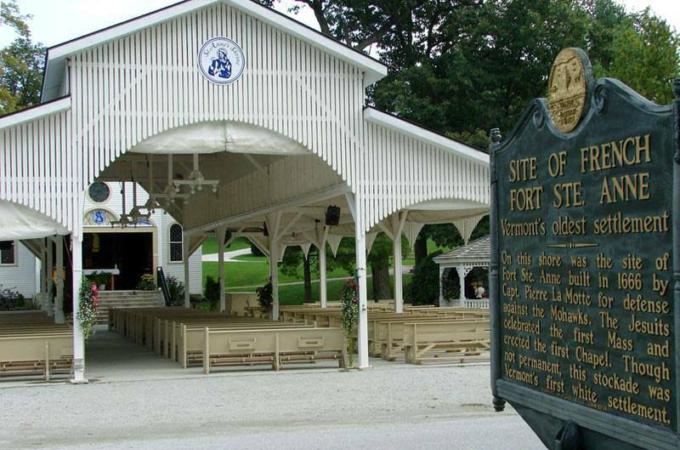Liturgy marks 350th anniversary of first Mass in Vermont by French
ISLE LA MOTTE, Vt. (CNS) -- In 1666, Jesuits celebrated the first Mass at the site of the French-established Fort Saint Anne, Vermont's oldest European settlement.
Today, the site is on Isle La Motte in Lake Champlain in the state's northwest corner. Scores of worshippers gathered Sept. 11 at the outdoor chapel at St. Anne's Shrine on the site for a Mass commemorating the anniversary.
Capt. Pierre La Motte built the fort as a defense against the Mohawks in the area. The Jesuits also erect the first chapel in Vermont on the site.
From that day to today, the celebration of the Eucharist "has been part of our lives in this great state," Bishop Christopher J. Coyne of Burlington, Vermont, said in opening the Mass.
He also acknowledged the significance of the date of the Mass, Sept. 11, asking worshippers to remember victims of all war and terrorism as the nation commemorated and mourned the terror attacks on the United States 15 years earlier.
The liturgy was a votive Mass for peace.
Jesuit Father Michael Knox, director of Martyrs' Shrine in Midland, Ontario, explained that the founding of Fort Saint Anne occurred during a moment of the history of the Jesuits in New France that could be declared a proverbial renaissance for the mission.
"Inspired by the still-recent deaths of St. Jean de Brebeuf and his companions, welcoming an ever-increasing number of French to the region and set to ever-expand their apostolic efforts among the Iroquois people, it is no surprise that one of the fathers would accompany Pierre de St. Paul, Sieur de la Motte, in its establishment," he said.
During his homily, Father Knox said the French explorers who brought Jesuit missionaries with them to the island saw not only new land but new hope, a new source of prosperity and a new opportunity to live out the Gospel message.
The French built the fort to "protect their vision," said Father Knox, a lecturer at Regis College at the University of Toronto, who wrote his doctoral thesis on "The Rhetoric of Martyrdom in the Jesuit Relations, 1632-1650."
That first Mass, he said, was an acknowledgement of God's presence in all things and everywhere.
"Today we share in the same Mass that was said here 350 years ago," Father Knox said. "We now share in an event they shared in then, and we share their hopes."
St. Anne's Shrine today is a place where visitors can walk on sacred ground amid images of Jesus and the saints, a place to be renewed by the Eucharist and in the sacrament of reconciliation, he continued. "What a gift it was 350 years ago to have Christ come to us in this holy place," he said.
Anniversaries are reminders of history, and "we should pause to reflect from where we have come and to where we have arrived," explained Edmundite Father Brian J. Cummings, the shrine's spiritual director. "The shrine is one of the most important religious and historical sites in Vermont, and it is good for our Catholic community to remind ourselves of the role faith played in the settlement of our country."
Sitting in her car parked just off the road near the chapel was Leona LaPiere of Chazy, New York. The 83-year-old said she has difficulty walking and finds it easier to sit in her car and listen to the outdoor Mass. She emphasized the importance of the liturgy and said the celebration of the anniversary was "beautiful."
Nancy and David Dulude of St. Albans, Vermont, also attended. The thought of Mass being said in the state for 350 years is humbling, Nancy Dulude said. That the French had the vision to bring their faith to New France and to Vermont where the site of the first Mass is now "a place of love and peace" in the midst of a troubled world was inspiring, she said.
The shrine, she added, is a "treasure and a legacy too, and we need to take care of it to pass it on and have younger folks feel vested in it and pass it on for another 350 years."
- - -
Urban is content editor and staff writer for Vermont Catholic, publication of the Diocese of Burlington, Vermont.



















